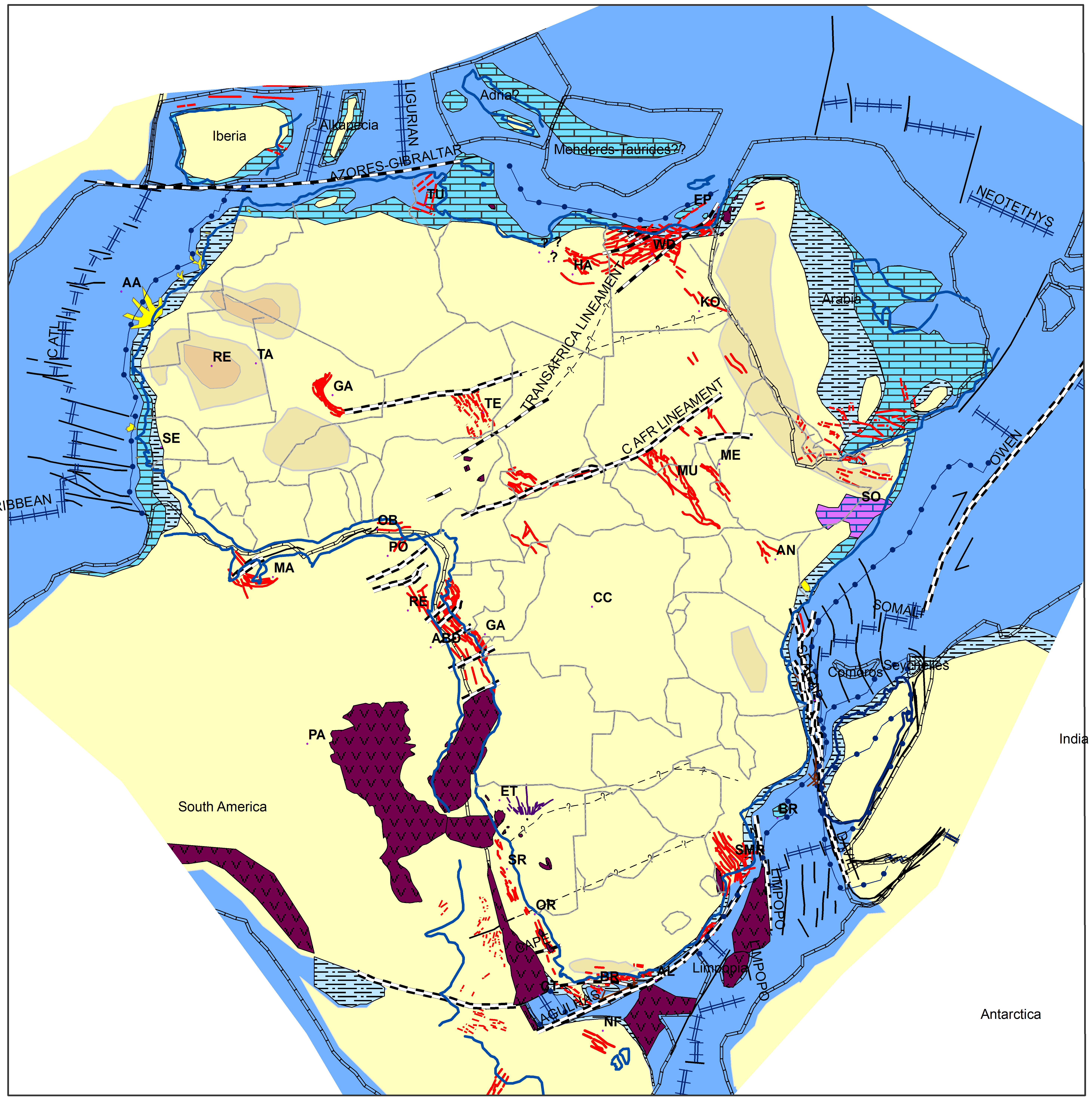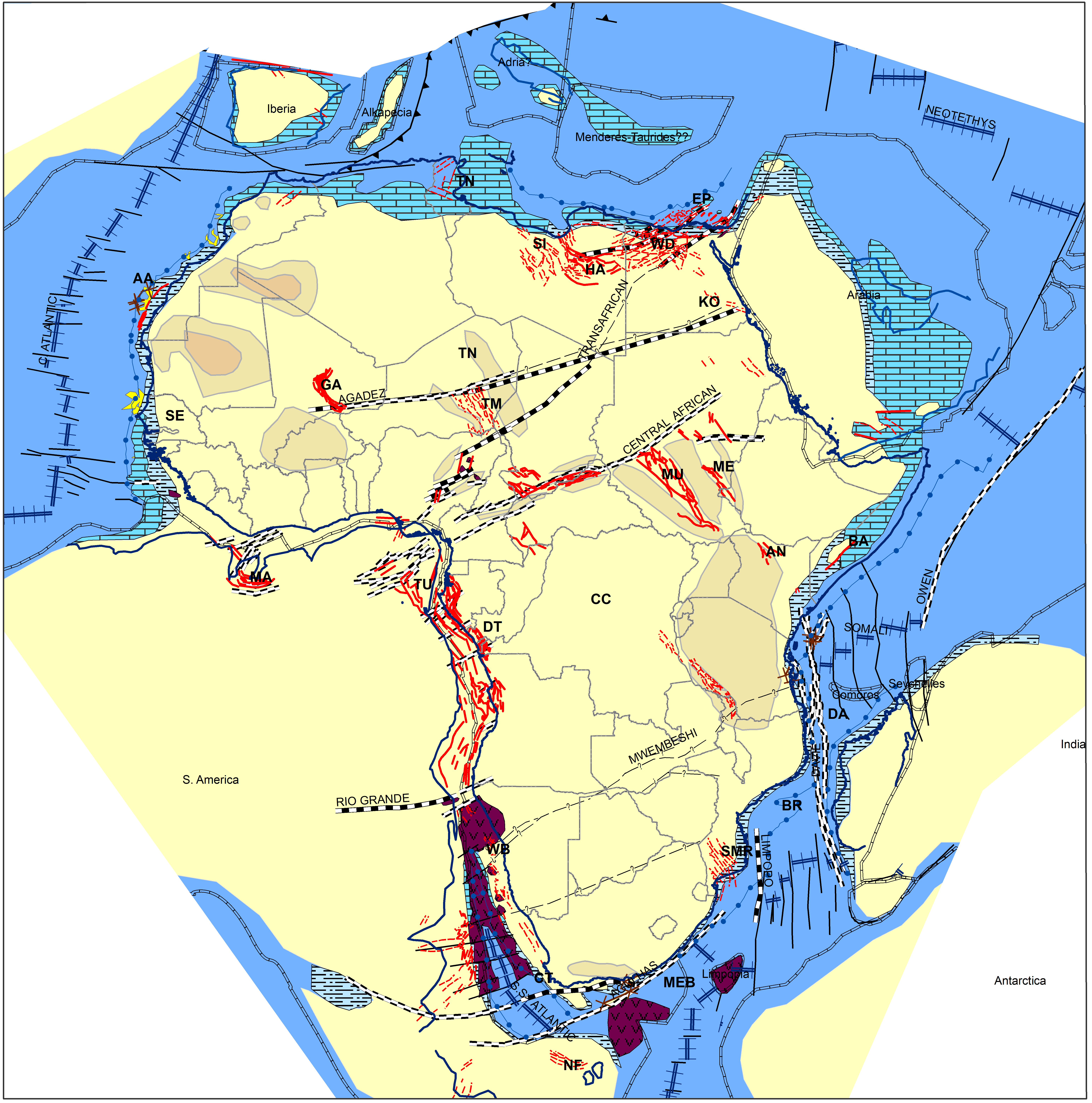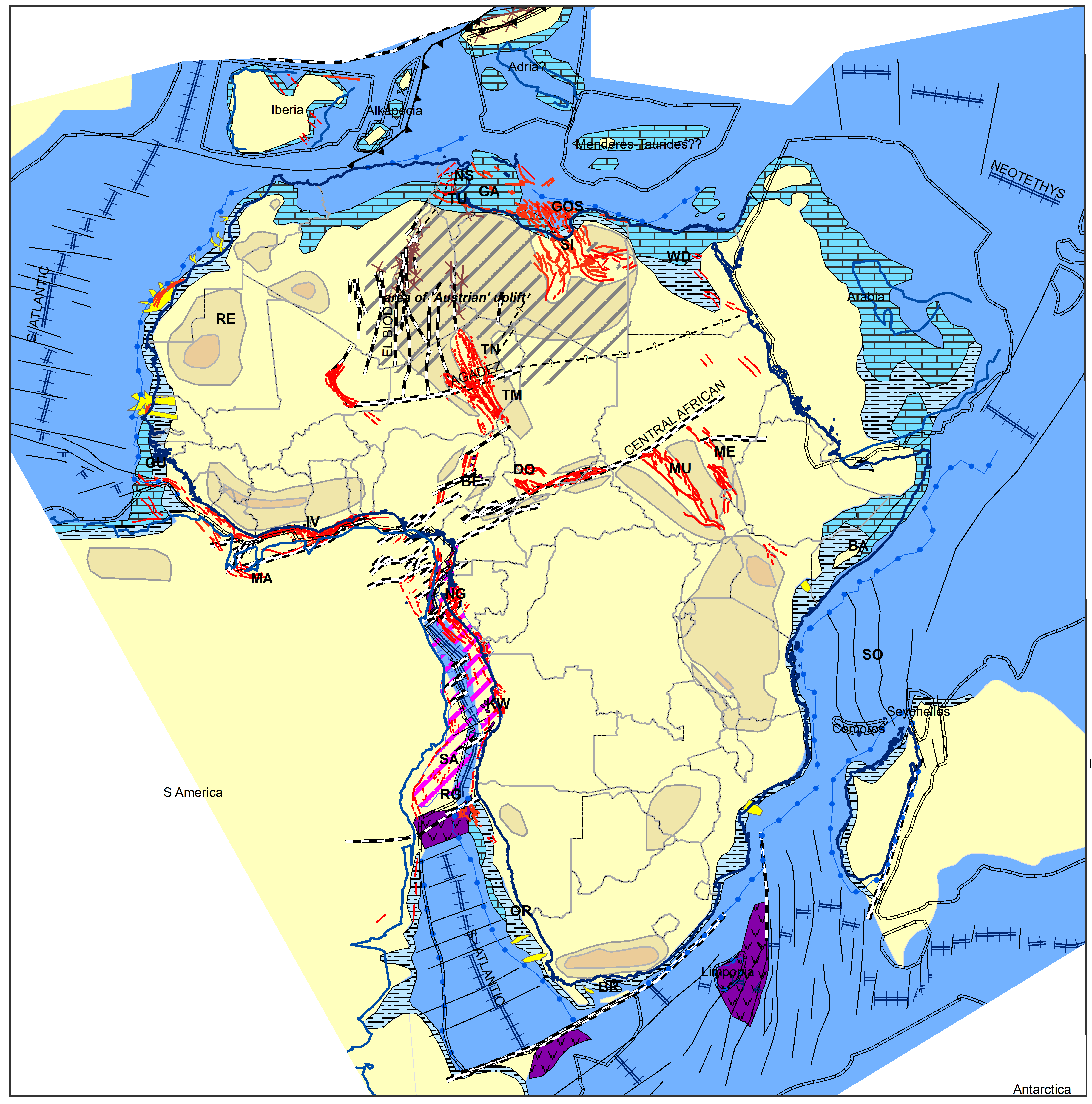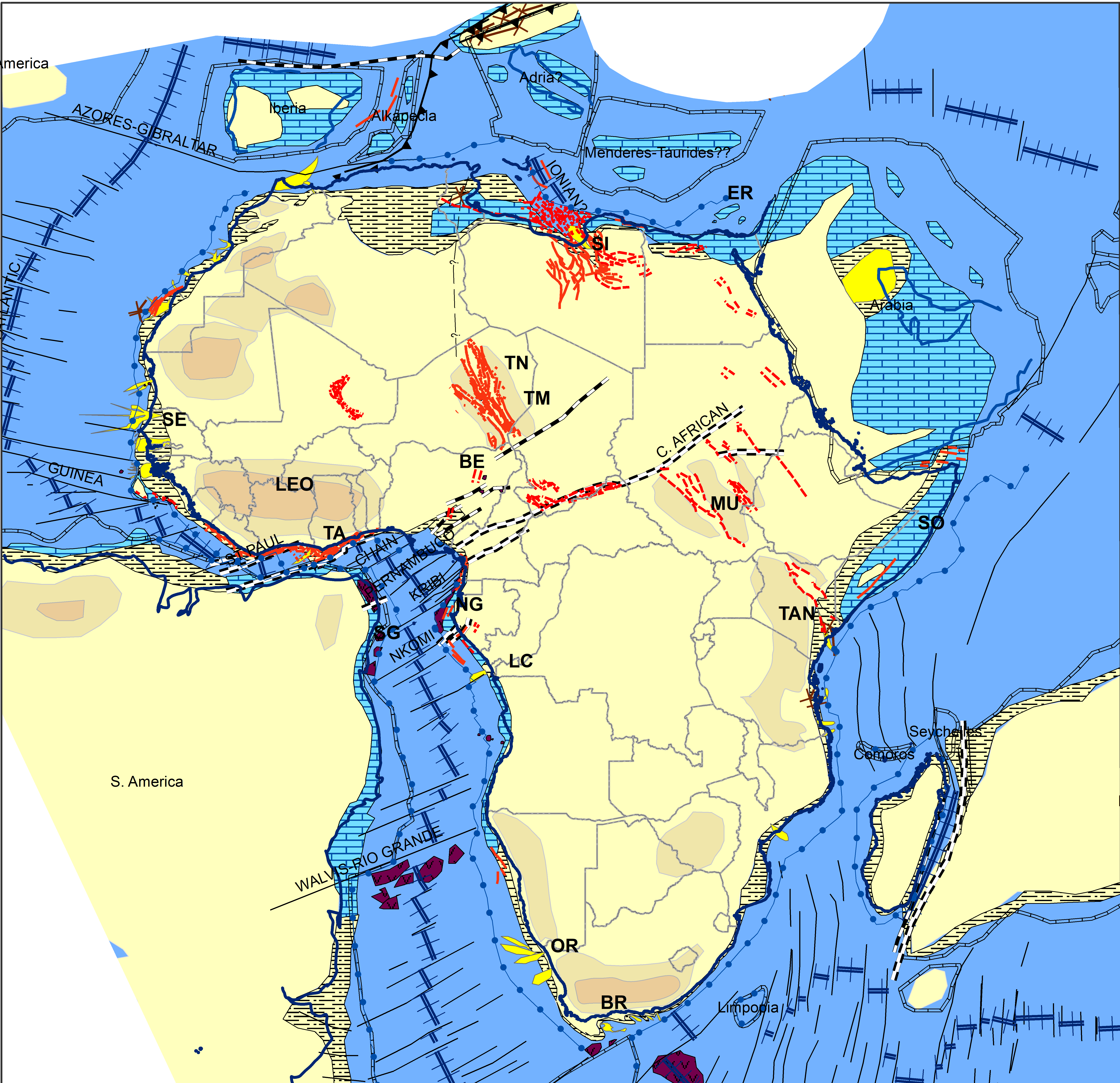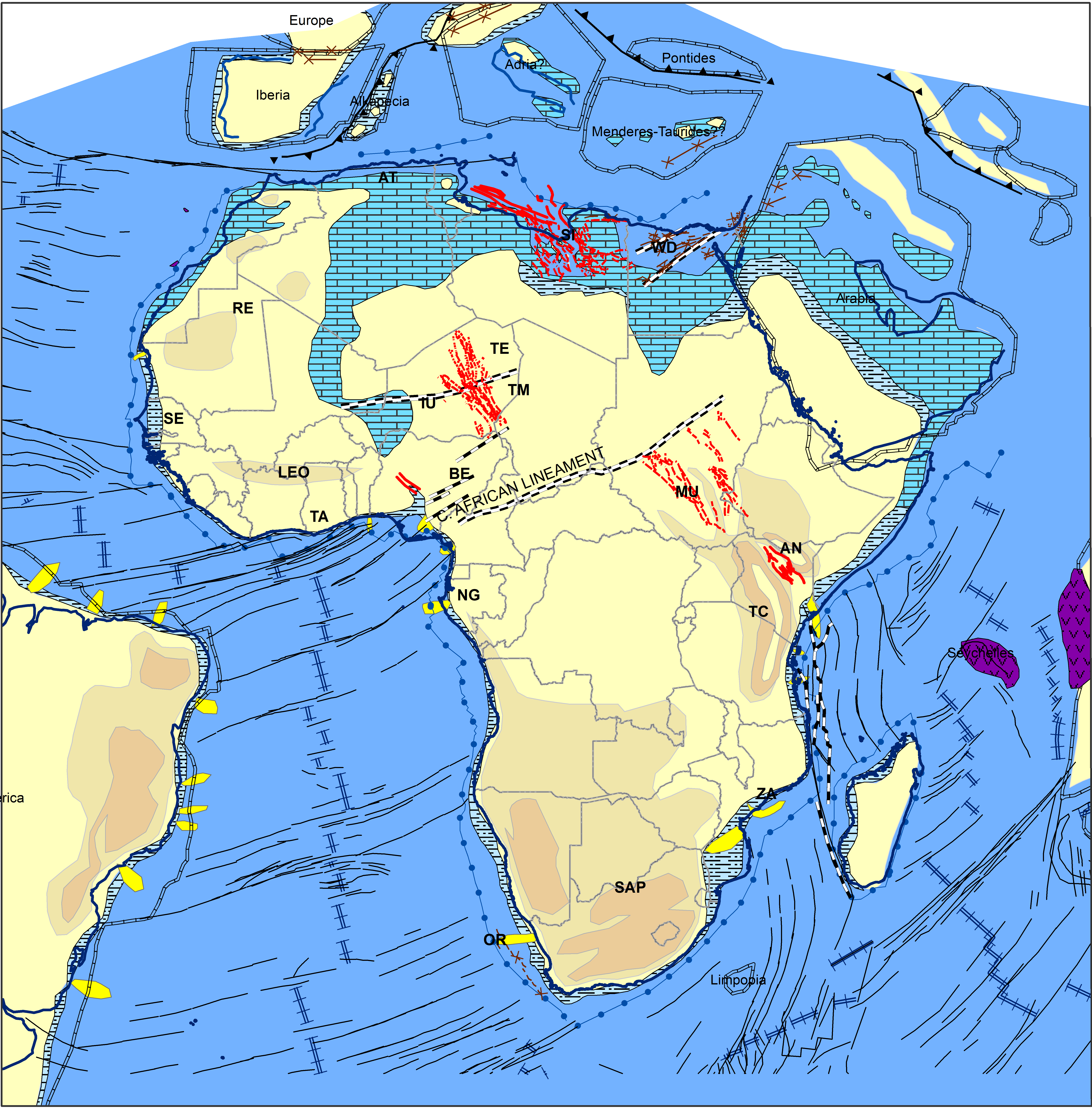This website is out of date and will shortly be deleted
Click here for new website and latest maps
CRETACEOUS PALEOTECTONIC AND PALEOGEOGRAPHIC MAPS OF AFRICA
DRAFT 3 MARCH 2023
An ongoing project using the plate model of Colin Reeves (www.reeves.nl)
Comments welcomed
CLICK MAPS TO EXPAND
WATCH AT https://www.youtube.com/watch?v=YoNYyLGlxjA
Late Valanginian-Early Hauterivian 135Ma
The South Atlantic commences a process of step by step unzipping, within a segment created between the Agulhas and Cape Transforms Macdonald et al (2003) . A Valanginian sequence is seen on seismic lines confined to this area (Simons et al, 2021). To the north, a volcanic margin is staring to form withe the eruption of seaward dipping reflectors. The Falklands Ridge is now moving rapidly westwards along the Agulhas transform margin. In East Africa, the Davie (DA) and associated transforms are now formed and are transporting Eastern Gondwana to the south.
The whole of the African plate would appear to be experiencing NE-SW stretching, creating a series of NW-SE dip slip rifts, bounded by E-W trending transforms. As part of this, a third rift phase is initiated in the Western Desert (WD) of Egypt with an extension into the Hameimat (HA) Basin. The orientation of these basins relative to the regional stress demonstrated by the Komombo (KO) and other dip-slip rifts to the south, suggest these are of trantensional origin, as proposed by Salgado (2015).
NW-SE trending rifts are active across the plate. In many cases, e.g. those of the south Atlantic, these rifts are not as yet in their main ‘syn-rift’ phases and a fine balance may have existed between sedimentation and subsidence, leading to these rifts being filled with clastics at this time. It is notable that rifting at this time is more intense off Gabon than it is off Angola, counter to the general unzipping trend of South Atlantic basins. The Parana (PA)-Etendeka(ET) Plume is represented by volcanics in SE Brazil, Namibia and Angola. Three seed points are created for what will eventually become a connected dextral transform system: the Marajo Basin (MA) of Brazil, a series of transforms in NE Brazil and the Sudanese parts of the Central African Lineament (CAL) .
Barremian 130Ma
Further step-like advance of the South Atlantic occurs northwards from the Cape Transform (CT) to Walvis Bay (WB), bounded by a major volcanic centre (Serica, 2014) and a transform. Widening of existing oceans continues elsewhere, particularly the now N-S directed spreading of the various segments of the Indian Ocean, connected along the Davie (DA) and Limpopo (LI) transforms. Movement on the Agulas Transform inverts the Diaz Ridge (DR)
In Libya, rifting may start to spread from the E-W trending Hameimat (HA) Basin to the main NW-SE trending Sirt (SI) Basin rifts, though there is poor control on this deep section. The Tenere (TN) Basin of Chad and Niger continues to rift, but probably not the Termit (TM) Basin (Genik, 1993), suggesting the existence of another transform. Rifting is intensified through the various rifts of the Central African Rift System (Genik, 1993), with parts of the Benue Trough (BE) possibly becoming active around this time, dating again being unclear. Transform tectonics along the trend from the Marajo (MA) Basin to Sudan intensifies but is not yet continuous. Much of this is likely driven by increased rifting of the Southern Atlantic system, expending now from a volcanic centre in northern Namibia till it meets the transform system at the northern limit of the Tucano (TU) Basin. Peak rifting of the Gabon-Angola system seems to be achieved at this time with deep lakes forming as subsidence overwhelms sedimentation (Chaboureau et al, 2012). A major river derived probably from the Cuvette Centrale, appears to enter the northern part of the Dentale Trough (DT) and then turn southwards, depositing a very thick fluvial clastic section, though no marine outlet is apparent.
.
Aptian 118Ma
The Cretaceous Quiet Zone is entered at 121Ma. Clear South Atlantic ocean now exists south of the Rio Grande (RG) volcanic ridge. The age of initial spreading north of this ridge is constrained to Early Aptian (~118Ma) by a) evidence for a continuous hyperalkaline lake covering the Santos (SA) and Kwanza (KW) Basin prior to this (Ceraldi and Green, 2016) and b) evidence that the salts of Africa and Brazil were separated by a ?volcanic ridge (Caixeta et al, 2014). A major peneplanation unconformity at 118Ma may, by analogy to some other continental margins, be related to flow of ductile lower crust towards the continent during break-up. Rifting in Gabon prior to 118Ma is continuous from the Barremian, though in Angola a large ‘sag’ basin is developed instead (Chaboureau et al, 2012), again likely related to lower crustal movements. The margin is now in a hyperextended state. The complex set of facies developed in the Aptian in this region is simplified by showing on a base polygon the regions in the Early Aptian where coarse fluvial clastics and lacustrine carbonates dominate, while the overlying hatched pattern shows the Late Aptian salt .
A continuous dextral shear zone is now developed between the Marajo (MA) Basin and Sudan (Popoff, 1988; Ye et al , 2019), integrating the youngest segment off Cote D’Ivoire. In North Africa, the Late Aptian ‘Austrian event’ includes a) a widespread uplift and unconformity of late Aptian age on which erosion increases towards the active Libyan rifts (Reeh et al ,2019) , b) extensional faulting in Tunisia and offshore Libya and c) sinistral transpressional structuring along shear zones in eastern Algeria and possibly on the N-S axis of Tunisia. The map shows a connection of lineaments, extending from the shear zones of central Africa to the Niger rifts and then through transforms to Tunisia, which can be construed as a segmentation of Africa into two plates (Guiraud et al, 2005). The trend may extend further to the Apulia plate margin, where the first significant ‘Eo-Alpine’ compressions are occurring. Bodin et al (2010) splits the ‘Austrian’ into two events in the Late Aptian and Middle Albian and correlates these to unconformities in the onshore Sirt (SI) and Gulf of Sirt (GOS) rifts. This and the development of a 'triple junction' between the rift branches suggests that these rifts developed as ‘active’ rifts associated with a large regional swell.
Late Albian - Early Cenomanian ~ 102Ma
South Atlantic spreading has propagated further north, with the north Gabon – Sergipe Basin segment opening as a volcanic margin in the early Albian (Caixeta et al, 2014), now reaching as far asthe E-W transform trend off Nigeria . South America now separates from Africa on fracture zones such as the Romanche and St Paul. Discontinuous segments of new transform-bounded ocean appear off Ghana by 105Ma, bounded by areas of hyperextension and severe crustal thinning. these do not join upp into a continuous ocean for another 10Ma (Antobreh et al, 2009). This final separation is marked by gravitational collapses and major erosional unconformities. The final contact between African Plate and the Maurice Ewing Bank (MEB) occurs around the same time. Consequently from Cenomanian times onwards (circa 95Ma), a freely circulating Atlantic Ocean is formed, allowing features such as contourite currents and mounds to form. This seems to cause a slight wettening of the climate.
Activity in North Africa is concentrated in the NW-SE arm of the Sirt (SI) Basin, where a major unconformity at the top of the Late Albian separates non-marine from marine influenced strata. Jagger et al (2018) has suggested a reactivation of Ionian (IO) Sea spreading at this time, which would be a continuation of the trend of Sirt Basin rifting. Most Central African rifts are, perhaps puzzlingly given the transform activity at this time, in a post-rift phase at this time , an exception being major rifting in Niger, which covers the Tenere (TN) as well as the Termit (TM) Basins
Santonian 86Ma
At 86Ma, the African plate takes a sharp turn and starts to drift northwards towards Europe (Guiraud. 1998). This change is likely the main cause of the inversions seen at this time. These are significant in the Western Desert (WD, Bosworth, 1999), extending through to Israel (‘Syrian Arc I’), while milder effects are seen in the Algerian Atlas. In the Gabes (GA) and Sabratah (SA) Basins, the event interrupts a rift phase, possibly caused by dextral movement on the bounding faults (Reeh, 2015). Active extension continues in the NW arm of the Sirt Basin , while there are limited reports of dextral fault movements on the now-inactive Hameimat arm (HA, Gras and Thusu, 1998), which could be an extension of the Alamein inversion trend in Egypt. The ‘passive rift’ or ‘pull apart’ model for the Sirt (SI) Basin therefore has some regional support at this time only. Major inversion is seen in E-W trending basins of the CARS, continuing along the Romanche transform (Antobreh et al, 2019). It would appear that this trend is subjected to a short lived reversal, possibly related to a change in the relative spreading rates of different portions of the Atlantic. Inversion effects extend as far as the Mandera Lugh (ML) Basin of Kenya (Bosworth) and also may cause a reversal of the Davie Transform.
Maastrichtian-Danian 65Ma
Following the tectonically active episodes captured on the previous three maps, there is a return to relative tectonic quiescence from the Campanian onwards. Regions such as the Atlas (AT) and Tunisia become dormant. Differing authors disagree whether the Sirt (SI) Arm is still in a syn-rift phase or has entered the post-rift (Abdunaser and Mcafferty, 2014) , but the stretching factor has certainly decreased since the Santonian (Abadi et al, 2008). A second phase of inversion affects the Western Desert (WD) basins. The pull-apart basins along the Central African lineament have become inactive, while uplift and erosion affect the Tenere (TN) and Termit (TM) Basins of Niger from the Maastrichtian onwards (Blaisse, 2019), terminating the marine inlet there. A similar decrease in the intensity of rifting is observed in the Sudan Basins though the Anza (AN) Basin is at peak rifting (Morley et al, 1999), indicating a lack of correlation between these two sets of basins. The KT boundary coincides with the Deccan Plume basalts of India, but these still cover the Seychelles microcontinent.
Main References
under construction.
